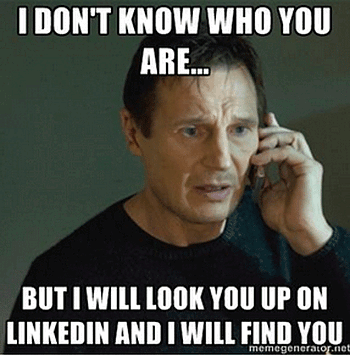 Picture this. You’ve just received some compelling information about a product or service that’s got you curious. The information came from a salesperson for a possible vendor. What’s the first or second thing you do?
Picture this. You’ve just received some compelling information about a product or service that’s got you curious. The information came from a salesperson for a possible vendor. What’s the first or second thing you do?
If you’re like me, you check out the salesperson’s LinkedIn profile, as well as the company’s and their website. While I’ve written before about what needs to happen to position your website to drive leads, I’ve become increasingly aware of just how badly organizations are positioned on LinkedIn.
While businesses spend tens to hundreds of thousands preparing beautiful sales collateral, they’re likely to completely ignore LinkedIn. Heck, they’ve got a profile they set up 10 years ago, that should be good enough shouldn’t it?
Of course not. Increasingly, for B2B sales, LinkedIn is becoming almost as important as your website to support your lead generation and sales efforts.
1. Your profile needs to be up-to-date and align with your current website and messaging
You’d think I wouldn’t need to share the first two points, but I’m shocked by how often a LinkedIn profile is old, boring or simply out of touch.
When your website says one thing, your profile says something else (or nothing) and the voice mail message you left creates a third message, the end result is avoidance. Everything you do needs to align with each other. If your website messaging changes, so do much all of the profiles.
2. Use a recent picture that is meant for LinkedIn
The web is a visual medium, and LinkedIn has invested a lot in allowing you to take advantage of that fact. Now it’s your turn. Your picture should be bright and take full advantage of the space provided.
There’s nothing worse than looking at some old picture, or one where I can see that you’re there in the distance. As the saying goes, there’s only one chance to make a first impression. If you’re in B2B sales, that first impression is often that photo.
3. Use a relevant, interesting headline
Your headline should catch someone’s eye, telling them why you matter. This is your opportunity to turn what you do into a benefit. But it can get tricky here.
Headlines like “Account Manager” are boring and increase the likelihood that you’ll be ignored. Headines like “Chief Dishwasher” might make you laugh, but they come across as too cute by half and more often than not diminish you in the eyes of your prospect.
Remember, buyer personas matter here. You’re not writing your headline for you or your friends – you’re writing for them. They should be clearly and easily understood.
4. Utilize the summary to deliver your Commercial Teaching Point-of-View
I’m dismayed how often people just ignore the summary section (or write a treatise). The summary section is where your elevator speech resides. Tell visitors the problems you solve, how you solve them and what you do.
5. Share content and resources
Your LinkedIn profile is not your resume. It’s your opportunity to highlight who you are, what you do and why it matters. Get active and share content. Highlight company blog posts, articles you find interesting and observations.
Give people samples of what you (or your company) do. Share your sales tools and make your profile a point of engagement for prospects. In the Zero Moment of Truth (ZMOT), it’s quite possible that this will be the difference between getting an opportunity to pursue or being ignored.
6. Connect and engage
What’s it say about you when, in 2014, someone visits your profile and sees you have 76 connections? There’s simply no reason that you shouldn’t be connected with hundreds of people.
Join groups and follow companies as well. This can be a bit tricky. LinkedIn is not Facebook. This is your professional profile, so keep in mind that professional contacts will be paying attention to the groups you belong to. But, don’t join every group or follow every company out there. Keep in mind that the people (and groups) you associate with tell people a lot about who you are.
7. Show some personality
While staying on message and alignment are crucial, you should not be robotic. Give people a picture into who you are as a person. It’s okay to break a rule or two, if it’s authentic, and let’s people more easily connect with you. Have some fun in the process.
There are lots of great resources for taking your LinkedIn efforts up a notch (I highly recommend The Ultimate Cheat Sheet for Mastering LinkedIn), that are all well worth the effort. These 7 tips will get you 80% of the way there and ensure that you never lose an opportunity because of your profile.

 Doug Davidoff
Doug Davidoff